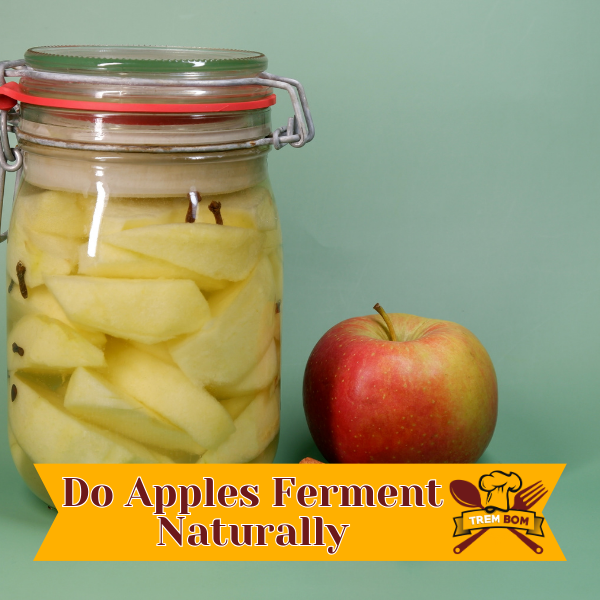
Welcome to our exploration of the natural fermentation process of apples! Have you ever wondered if apples can ferment on their own? In this article, we will delve into the fascinating world of apple fermentation and uncover the secrets behind this natural phenomenon. Join us as we discuss the steps involved in the apple fermentation process and provide insights into the unique flavors and characteristics that result from it.
Key Takeaways:
- Apples can ferment naturally due to the presence of natural yeasts on their skins.
- The apple fermentation process involves the conversion of sugars into alcohol and carbon dioxide.
- Natural apple cider fermentation enhances the flavors and aromas of the final product.
- Home fermentation of apples can be done using simple steps and techniques.
- Natural apple fermentation is utilized in various apple products, such as apple cider vinegar and apple-based alcoholic beverages.
Understanding Natural Apple Cider Fermentation
In the world of apple cider, natural fermentation is a process that adds depth, complexity, and incredible flavors to this beloved beverage. But what exactly is natural apple cider fermentation, and what are the benefits it brings? Let’s explore the fascinating world of natural apple cider fermentation and discover the unique characteristics that make it so enticing.
The Benefits of Natural Apple Fermentation
When apples ferment naturally, it allows the flavors and aromas to develop in a way that cannot be replicated through artificial means. The slow fermentation process helps to break down sugars, creating a balance of sweet and tangy notes that dance on the palate.
Furthermore, natural apple cider fermentation introduces probiotics and enzymes that are beneficial to our digestive health. These live cultures can support a healthy gut microbiome and improve nutrient absorption.
Here are some key benefits of natural apple fermentation:
- Enhanced flavors and aromas
- Increase in beneficial enzymes and probiotics
- Promotion of a healthy gut microbiome
- Improved nutrient absorption
Flavors and Characteristics of Naturally Fermented Apple Cider
The natural fermentation process results in a wide range of flavors and characteristics that can vary depending on the apple variety, fermentation duration, and environmental conditions. Some common flavors and characteristics found in naturally fermented apple cider include:
Rich apple flavors
Subtle hints of citrus
Delicate floral undertones
Complex layers of sweetness and acidity
Smooth and velvety mouthfeel
Comparing Natural Fermentation to Traditional Methods
While traditional fermentation methods may involve the addition of commercial yeasts or sugars, natural apple cider fermentation relies solely on the wild yeasts present on the apple skins. This allows for a more authentic and nuanced flavor profile, showcasing the true essence of the apples.
Here is a comparison between natural fermentation and traditional methods:
| Natural Fermentation | Traditional Methods |
|---|---|
| Relies on wild yeasts | May use commercial yeasts |
| Longer fermentation process | Shorter fermentation process |
| More complex flavors and aromas | Simpler flavor profile |
By embracing natural apple cider fermentation, we can savor a beverage that captures the true essence of apples while benefiting from the multitude of flavors, aromas, and health advantages that this natural process brings. Whether you prefer your apple cider sweet, tart, or somewhere in between, natural fermentation is the key to unlock a world of unforgettable flavors.
The Fascinating Process of Apple Fermentation
Apples are not only delicious and nutritious but also possess the remarkable ability to undergo fermentation without the addition of yeast. This natural process is facilitated by the presence of wild yeasts that reside on the apple skins. These yeasts, along with the sugars present in the apples, initiate a series of chemical reactions that transform the apples into fermented delights.
When apples are harvested and begin to ripen, the natural yeasts on their surface become more active. These yeasts consume the sugars in the apples and convert them into alcohol through a process called alcoholic fermentation. This primary fermentation stage is driven by the anaerobic respiration of these wild yeasts, which do not require oxygen to carry out the fermentation process.
“The wild yeasts on apple skins play a crucial role in the initial stages of apple fermentation, breaking down sugars into alcohol.”
As the wild yeasts convert the sugars into alcohol, carbon dioxide gas is also produced as a byproduct. This effervescence gives fermented apple products their characteristic bubble and adds a unique texture to the final product.
It is important to note that the wild yeasts on apple skins can vary, leading to different flavors and aromas in the fermented apple products. These variations can contribute to the diversity and complexity of apple fermentation, making each product truly unique.
The chemical reactions that occur during apple fermentation involve the conversion of sugars into alcohol, the release of carbon dioxide gas, and the development of complex flavors and aromas. The duration of fermentation and the specific conditions during the process can influence the final taste profile of the fermented apples.
To provide a clearer understanding of the fascinating process of apple fermentation, we have compiled a table summarizing the key facts:
| Fact | Description |
|---|---|
| Role of natural yeasts | The wild yeasts on apple skins consume sugars and convert them into alcohol. |
| Alcoholic fermentation | Wild yeasts carry out anaerobic respiration, converting sugars into alcohol. |
| Effervescence | Carbon dioxide gas is released during fermentation, creating bubbles in the final product. |
| Flavor variations | Different wild yeasts on apple skins contribute to the diverse flavors and aromas in fermented apple products. |
| Chemical reactions | The fermentation process involves the conversion of sugars, release of carbon dioxide, and the development of complex flavors. |
The natural fermentation of apples is a fascinating process that showcases the incredible biological capabilities of nature. By harnessing the power of wild yeasts and understanding the chemical reactions that occur, we can appreciate the intricate art of apple fermentation and savor the delicious outcomes it produces.
Fermenting Apples at Home
Are you ready to embark on a flavor-filled journey of fermenting apples at home? With our step-by-step guide and useful tips, you’ll discover the joy of creating your own homemade apple fermentation. Get ready to savor the unique tastes and aromas that come from this natural process.
Step 1: Choosing the Right Apples
Start by selecting fresh, high-quality apples for your fermentation. Opt for organic varieties if possible, as they tend to have a higher concentration of natural yeasts that aid in the fermentation process. Varieties such as Granny Smith, Jonagold, or McIntosh work well, but feel free to experiment with different types to create your preferred flavor profile.
Step 2: Cleaning and Sanitizing
Thoroughly clean your apples to remove any dirt or debris. It’s essential to sanitize all equipment that will come into contact with the apples and the fermentation process. This includes jars, utensils, and fermentation vessels. Proper sanitization helps prevent the growth of unwanted bacteria and ensures a successful fermentation.
Step 3: Preparation and Crushing
Peel and core the apples, then chop them into small pieces or crush them using a fruit press. Crushing the apples releases their natural juices, providing a solid foundation for fermentation. Don’t discard the peels and cores; they contain beneficial natural yeasts that contribute to the fermentation process.
Step 4: Initiating Fermentation
Transfer the crushed apples to a fermentation vessel, making sure it is clean and sanitized. If you have wild yeast present on the apple peels and cores, there is no need to add any additional yeast. However, if you prefer a specific yeast strain, you can add a suitable commercial yeast product. Seal the vessel with an airlock to allow the carbon dioxide produced during fermentation to escape while preventing oxygen from entering.
Step 5: Patience and Monitoring
Place the fermentation vessel in a cool, dark place and let nature take its course. Fermentation time can vary depending on factors such as temperature, apple variety, and desired flavor intensity. Regularly monitor the fermentation process, checking for any signs of mold or unpleasant odors. A healthy fermentation will showcase bubbling activity and a pleasant, fruity aroma.
Step 6: Bottling and Aging
Once the desired level of fermentation is achieved, it’s time to transfer your fermented apple concoction into bottles. Use a siphon to carefully separate the liquid from any sediment or solids. Seal the bottles and store them in a cool place for further aging. This additional time allows the flavors to develop and mellow, resulting in a richer and more complex taste.
Step 7: Enjoying Homemade Fermented Apples
After the aging process, your homemade fermented apple creation is ready to be enjoyed! Serve it chilled or at room temperature and savor the unique flavors and aromas that only natural apple fermentation can provide. Enjoy it on its own or use it as a delicious ingredient in cocktails, marinades, or salad dressings. The possibilities are endless!
So, gather your apples, follow these steps, and immerse yourself in the delightful experience of fermenting apples at home. Get ready to impress your family and friends with your homemade fermented apple creations!
| Benefits | Instructions | Tips |
|---|---|---|
| Enhanced flavor | Follow our step-by-step guide | Choose organic apples for optimal natural yeast content |
| Increased nutritional value | Sanitize all equipment | Regularly monitor fermentation process for signs of mold or unpleasant odors |
| Customizable flavor profiles | Crush apples to release natural juices | Consider experimenting with different apple varieties |
| Cost-effective | Initiate fermentation with natural yeasts on apple peels and cores | Store fermented apples in a cool, dark place for aging |
Natural Fermentation in Apple Products
In this section, we will explore how natural fermentation is utilized in various apple products. From apple cider vinegar to apple-based alcoholic beverages, we will uncover the diverse range of products that benefit from the natural fermentation of apples.
The Versatility of Apple Fermentation
Apples have long been celebrated for their versatility and the countless products that can be derived from them. Natural fermentation enhances the flavors, aromas, and nutritional value of apple products, making them even more enjoyable.
“Natural fermentation adds depth and complexity to apple products, creating unique taste profiles that cannot be replicated through other methods.” – Sarah Green, Apple Products Expert
Apple Cider Vinegar: A Tangy Delight
Apple cider vinegar is a beloved pantry staple known for its tangy flavor and numerous health benefits. Made through a two-step fermentation process, apple cider vinegar is rich in beneficial enzymes and probiotics.
Hard Cider: An Apple-Based Elixir
Hard cider, also known as apple cider or alcoholic cider, is a refreshing beverage with a long history. The natural fermentation of apple juice allows the sugars to convert into alcohol, resulting in a crisp and effervescent drink.
Apple Wine: A Fine Vintage
Apple wine, often referred to as apple cider wine, is a delightful variation of traditional grape wine. Made from fermented apples, apple wine showcases the unique flavors and characteristics of different apple varieties.
Apple Brandy: A Distilled Delicacy
Apple brandy is a distilled spirit that captures the essence of apples through fermentation and aging. This luxurious beverage offers a smooth and complex taste, with hints of apple and oak.
A Brief Comparison of Apple Products
| Apple Product | Taste | Alcohol Content | Usage |
|---|---|---|---|
| Apple Cider Vinegar | Tangy, acidic | Non-alcoholic | Culinary, medicinal |
| Hard Cider | Light, crisp, fruity | Low to moderate | Enjoyed as a beverage |
| Apple Wine | Varies based on apple variety and fermentation process | Can range from low to high | Pairing with meals or sipped on its own |
| Apple Brandy | Smooth, complex | Higher alcohol content | Sipped neat or used in cocktails |
These are just a few examples of how natural fermentation transforms apples into delightful products. From the tangy punch of apple cider vinegar to the elegant complexities of apple brandy, the possibilities are endless when it comes to enjoying the fruits of apple fermentation.
The Role of Wild Yeast in Apple Fermentation
Wild yeast plays a crucial role in the fascinating process of apple fermentation. When apples are left to ferment naturally, wild yeasts present on the apple skins initiate the fermentation process. These wild yeasts, which are naturally occurring microorganisms, consume the sugars present in the apples and produce alcohol as a byproduct.
What sets wild yeast fermentation apart is the unique flavors and aromas it imparts to the fermented apple products. Unlike commercial yeast strains, wild yeasts introduce a range of diverse flavors that can vary from batch to batch. This natural variation contributes to the complexity and depth of the final product.
The presence of wild yeast in apple fermentation is not only responsible for the enhanced flavors but also for the overall fermentation process. Wild yeasts break down sugars and convert them into alcohol, creating the characteristic tanginess found in fermented apple products. Additionally, wild yeasts help shape the acidity levels during fermentation, resulting in a well-balanced and flavorful end product.
It’s important to note that wild yeast fermentation can sometimes be unpredictable. The fermentation process may take longer compared to using commercial yeast strains, and the final product may exhibit slight variations in flavor and aroma. However, it is precisely this unpredictability that adds to the allure and charm of natural apple fermentation.
Uncovering the Benefits of Natural Apple Fermentation
When it comes to apple fermentation, natural methods reign supreme. Not only does this traditional process provide us with delicious apple-based products, but it also offers a range of benefits that cannot be replicated through other techniques.
The Enhanced Flavors and Aromas
One of the key advantages of natural apple fermentation is the depth and complexity it adds to the flavor profile of the final product. Through the natural fermentation process, the apples release their sugars, which are then transformed by yeasts into a multitude of flavors and aromas. This results in a more nuanced and satisfying taste that simply cannot be achieved through artificial means.
Increased Nutritional Value
Did you know that natural apple fermentation can enhance the nutritional value of the fruit? During fermentation, the yeasts break down the complex carbohydrates in apples into simpler sugars, making them more easily digestible. Additionally, fermentation can also increase the bioavailability of certain nutrients, such as vitamins and minerals, making them easier for our bodies to absorb.
Probiotic Richness
Natural apple fermentation also introduces beneficial bacteria into the final product, turning it into a rich source of probiotics. Probiotics are known for their positive effects on gut health, immune function, and digestion. By consuming naturally fermented apple products, we can support our overall well-being and promote a healthy gut microbiome.
Preservation and Longevity
Another remarkable benefit of natural apple fermentation is its ability to preserve the freshness and extend the shelf life of the fruit. The fermentation process creates an acidic environment that inhibits the growth of harmful bacteria and molds, ensuring that the apples and their products stay fresh for longer periods. This natural preservation method allows us to enjoy the flavors and benefits of apples throughout the year.
By harnessing the power of natural fermentation, we can unlock a world of flavors, nutrition, and preservation. Whether you’re sipping on a glass of homemade apple cider or enjoying a spoonful of apple cider vinegar in your salad dressing, the benefits of natural apple fermentation are undeniable.
| Benefits of Natural Apple Fermentation |
|---|
| Enhanced flavors and aromas |
| Increased nutritional value |
| Probiotic richness |
| Preservation and longevity |
Exploring Different Types of Apple Fermentation
In the world of apple fermentation, there is a diverse range of techniques and processes used to create unique flavors and characteristics. From traditional open-air fermentations to modernized controlled fermentations, let’s delve into the various types of apple fermentation methods:
1. Traditional Open-Air Fermentation
In this method, apples are left to ferment naturally in the open air. The apples are crushed and the juice is allowed to ferment using the wild yeasts present on the apple skins. This traditional approach often results in complex flavors and a distinct rustic quality in the finished apple products.
2. Spontaneous Wild Yeast Fermentation
Spontaneous wild yeast fermentation occurs when apples are naturally inoculated with wild yeasts present in the environment. This method allows for the expression of the unique local microbial populations, resulting in a wide range of flavor profiles and aromatic qualities.
3. Controlled Fermentation with Cultivated Yeasts
In controlled fermentation, specific strains of cultivated yeasts are added to initiate the fermentation process. This method allows for more consistent and predictable results, as the cultivated yeasts are selected for their ability to produce desired flavors and aromas. Controlled fermentation is commonly used in commercial apple fermentation to achieve a standardized product.
4. Carbonation Fermentation
In carbonation fermentation, the apple juice is fermented until it reaches the desired alcohol content, and then sugar is added to initiate a second fermentation. This second fermentation results in the production of carbon dioxide, creating the characteristic fizzy texture and refreshing bubbles in apple-based beverages.
“The different types of apple fermentation methods offer a wide range of flavors, aromas, and textures, appealing to a variety of tastes and preferences.” – Apple fermentation expert
Each of these apple fermentation methods has its own unique qualities and outcomes. Whether you prefer the rustic complexity of open-air fermentation or the consistency of controlled fermentation, there is a method that will suit your preferences. Exploring different types of apple fermentation can be a delightful journey of discovering new flavors and experiencing the rich traditions of apple fermentation.
Conclusion
In conclusion, we have explored the fascinating world of natural apple fermentation. By understanding the process, benefits, and techniques involved, we can truly appreciate the unique flavors and characteristics that arise from this natural phenomenon. Whether you’re fermenting apples at home or enjoying apple-based products, embracing natural fermentation methods offers a delightful way to experience the true essence of apples.
During our exploration, we discovered that apples have the remarkable ability to ferment naturally, thanks to the presence of wild yeasts on their skins. These yeasts play a vital role in the fermentation process, contributing to the complexity and depth of flavors found in fermented apple products.
Furthermore, natural apple fermentation offers a range of benefits. The flavors produced through this process are often more nuanced and vibrant compared to artificially fermented products. Additionally, the natural fermentation of apples can enhance their nutritional value by breaking down sugars and increasing the bioavailability of certain nutrients.
Whether you choose to try your hand at fermenting apples at home or enjoy the diverse array of apple-based products available in the market, embracing natural apple fermentation is a wonderful way to celebrate the rich heritage and flavors that apples have to offer. So, go ahead and savor the delicious taste of naturally fermented apples in all their glory!
FAQ
Do apples ferment naturally?
Yes, apples can ferment naturally. They contain natural yeasts on their skins that initiate the fermentation process when exposed to oxygen and sugar.
What is the apple fermentation process?
The apple fermentation process involves the conversion of sugars in apples into alcohol and carbon dioxide by yeasts. This process creates flavorful and tangy apple cider.
How do apples ferment without yeast?
Apples ferment without yeast because they have natural yeasts present on their skins. These yeasts convert sugars into alcohol through fermentation, eliminating the need for additional yeast strains.
Can I ferment apples at home?
Absolutely! You can easily ferment apples at home by crushing or juicing them, allowing the natural yeasts to initiate fermentation. With the right conditions and patience, you can enjoy homemade apple cider in no time.
What apple products undergo natural fermentation?
Various apple products undergo natural fermentation, including apple cider vinegar, apple wine, and apple brandy. Natural fermentation enhances the flavors and qualities of these products.
How does wild yeast contribute to apple fermentation?
Wild yeast, naturally present in the apple environment, plays a crucial role in apple fermentation. These yeasts introduce unique flavors and aromas, shaping the character of the fermented apple products.
What are the benefits of natural apple fermentation?
Natural apple fermentation offers several benefits. It enhances the flavor profile of the apples and increases the nutritional value. Natural fermentation also avoids the need for artificial additives, making it a healthier and more authentic process.
What are the different types of apple fermentation?
Different types of apple fermentation techniques include traditional open-air fermentation and modern controlled fermentations. Each method has its own characteristics and impacts the final product.






